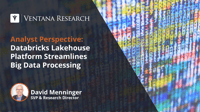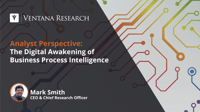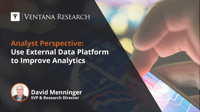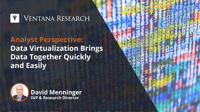The age of digital communication platforms is upon us. The need has never been greater for an open and secure platform that satisfies the demand for enterprise-grade business and technology requirements. Overcoming today’s technology challenges is possible with a next-generation cloud-based delivery model that is both extensible and reliable. Organizations considering a digital communication platform can take decisive steps to ensure digital communications for everyone — inside, outside,...
Read More
Topics:
Customer Experience,
Business Continuity,
Contact Center,
Digital transformation,
Digital Business,
Digital Communications,
Experience Management
I am very happy to announce that I have joined Ventana Research to help lead the expertise area of Digital Technology, including Analytics and Data, Cloud Computing, Artificial Intelligence and Machine Learning, the Internet of Things, Robotic Automation, and Collaborative and Conversational Computing. While the breadth of applications and technology covered by our Digital Technology practice is broad, I will naturally make use of my decades of experience covering data platforms and analytics...
Read More
Topics:
Digital Technology
To maximize the value of the workforce and the work conducted, organizations need to increase the effectiveness of workers assigned to critical, interrelated tasks. Doing so requires a commitment to planning the best use of workers and resources. Failing to do so can limit an organization’s ability to reach essential milestones and complete work related to business processes with customers, partners and across the supply chain.
Read More
Topics:
Business Continuity,
Operations & Supply Chain,
Digital transformation,
Digital Business,
Work Management
Managing corporate income taxes is a challenge for chief financial officers. Tax codes are often complex, so tax accounting as well as the data required for tax provisions and tax compliance are different enough from statutory accounting to create significant workloads for the tax department. Today, the worldwide trend to higher taxes and growing tax code complexity is increasing the payoff for digitizing an organization’s tax function.
Read More
Topics:
Office of Finance,
Financial Performance Management,
ERP and Continuous Accounting,
Revenue,
digital finance,
lease and tax accounting
Databricks is a data engineering and analytics cloud platform built on top of Apache Spark that processes and transforms huge volumes of data and offers data exploration capabilities through machine learning models. It can enable data engineers, data scientists, analysts and other workers to process big data and unify analytics through a single interface. The platform supports streaming data, SQL queries, graph processing and machine learning. It also offers a collaborative user interface —...
Read More
Topics:
embedded analytics,
Analytics,
Business Intelligence,
Collaboration,
Data Governance,
Information Management,
Data,
data lakes,
AI & Machine Learning
As the pace of digital innovation has accelerated, many organizations have found it harder to manage the portfolio of work conducted by the workforce to ensure timeliness and mitigate the risk of increased costs and resources. The challenges in managing the work related to project plans are not only to ensure the timeliness in performing and tracking the individual tasks and activities every single moment of the day, but also having the intelligence to adjust and guide all future work. The...
Read More
Topics:
Business Continuity,
Operations & Supply Chain,
Digital transformation,
Digital Business,
Work Management
The work environment today demands that your organization advances the efficiency to execute business processes for continuous operations to have a positive impact on business performance. The capability to be responsive to any range of minor to disruptive business events is required to support business continuity and level of organizational readiness to meet the needs of digital business. Ventana Research asserts that in 2025, one-quarter of organizations will remain digitally ineffective in...
Read More
Topics:
Customer Experience,
Voice of the Customer,
embedded analytics,
Analytics,
Business Intelligence,
Cloud Computing,
Contact Center,
Data,
Digital Technology,
Operations & Supply Chain,
Enterprise Resource Planning,
Digital transformation,
natural language processing,
continuous supply chain,
agent management,
Digital Business,
Experience Management,
Field Service,
Process Mining,
Streaming Analytics,
AI & Machine Learning
When artificial intelligence emerged from the labs and vendors started offering it as a component of their software, many contact-center buyers shied away from it. From their point of view, AI and machine learning tools were new, expensive, relatively untested and had an uncertain use case. This stance was understandable, as contact center professionals are traditionally expected to be risk-averse when deploying technology into their operations. Contact centers are, by design, supposed to be...
Read More
Topics:
Customer Experience,
Voice of the Customer,
Analytics,
Contact Center,
agent management,
Customer Experience Management,
Field Service,
AI & Machine Learning,
customer service and support
The subscription business model has seen much growth in all aspects of the market in recent years. Now considered the standard for the digital age, the model’s implementation travels parallel to rising technology, leading to the demand for newer functionality and tools. As more and more vendors create their own versions, and as the subscription model is increasingly adopted, technology solutions are also advancing to support a broader range of products and services, as well as industries.
Read More
Topics:
Sales,
Subscription Billing,
Subscription Management,
partner management
Access to external data can provide a competitive advantage. Our research shows that more than three-quarters (77%) of participants consider external data to be an important part of their machine learning (ML) efforts. The most important external data source identified is social media, followed by demographic data from data brokers. Organizations also identified government data, market data, environmental data and location data as important external data sources. External data is not just part...
Read More
Topics:
Analytics,
Business Intelligence,
Internet of Things,
Data,
Digital Technology,
Lease Management,
Streaming Data,
Streaming Analytics,
AI & Machine Learning
Tools for contact center agent management have changed considerably in the past few years. The suite of software applications has grown from those that perform core functions in scheduling and quality control to include more advanced solutions for agent guidance, integrated desktops, and workflow and automation design. One area of intense investment by vendors has been analytics, specifically for assessing customer satisfaction and hearing the “voice of the customer.”
Read More
Topics:
Customer Experience,
Voice of the Customer,
Contact Center,
agent management,
Customer Experience Management,
customer service and support
Price management and optimization is not a new discipline, but until now, it has been restricted to particular industries — such as discrete manufacturing and chemicals — where there are potentially hundreds if not thousands of stock-keeping units covering many interdependent products.
Read More
Topics:
Subscription Management,
Revenue Management,
profitability management,
pricing management
Strategic planning has always been difficult. But it is even more so in this age of rapid digital transformation and the pressure of business continuity, which has introduced disruptive changes. What’s needed, ironically, is a methodical approach to how an organization manages strategic planning to allow for beneficial disruption that is not avoidable, balancing finance and operations, engaging existing expertise and factoring in technology to ensure that new initiatives can be strategically...
Read More
Topics:
Performance Management,
Business Continuity,
Digital transformation,
Digital Business,
Digital Security,
Digital Communications,
Experience Management
The technology industry throws around a lot of similar terms with different meanings as well as entirely different terms with similar meanings. In this post, I don’t want to debate the meanings and origins of different terms; rather, I’d like to highlight a technology weapon that you should have in your data management arsenal. We currently refer to this technology as data virtualization. Other similar terms you may have heard include data fabric, data mesh and [data] federation. I’ll briefly...
Read More
Topics:
Analytics,
Data Governance,
Data Integration,
Data,
Digital Technology,
data lakes
Alteryx is a data analytics software company that offers data preparation and analytics tools to simplify and automate data wrangling, data cleaning and modeling processes, enabling line-of-business personnel to quickly access, manipulate, analyze and output data. The platform features tools to run a variety of analytic functions such as diagnostic, predictive, prescriptive and geospatial analytics in a unified platform, and can connect to various data warehouses, cloud applications,...
Read More
Topics:
embedded analytics,
Analytics,
Business Intelligence,
Collaboration,
Data Preparation,
Data,
AI & Machine Learning
























